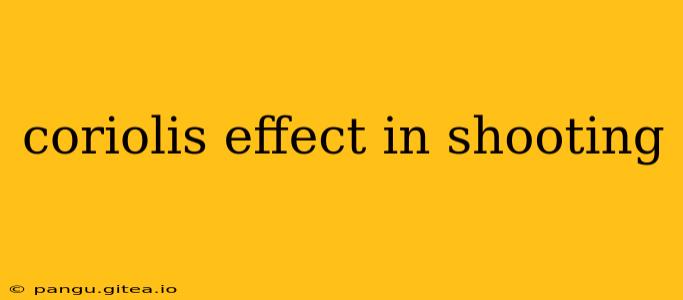The Coriolis effect is a fascinating phenomenon often cited in discussions about long-range shooting, particularly among those seeking a competitive edge or a deeper understanding of ballistics. But does it truly impact your shots, and if so, to what extent? Let's delve into the science and separate fact from fiction.
Understanding the Coriolis Effect
The Coriolis effect is an inertial force that appears to deflect moving objects (like bullets) to the right in the Northern Hemisphere and to the left in the Southern Hemisphere. This deflection isn't caused by a physical force acting on the projectile; instead, it's a consequence of the Earth's rotation. As the Earth spins on its axis, different points on the Earth's surface are moving at different speeds. A bullet fired from a rifle, for instance, retains its initial momentum relative to the Earth's surface at its point of origin. However, as the Earth rotates beneath the bullet, the target's position appears to shift relative to the bullet's trajectory.
The Impact on Long-Range Shooting
While the Coriolis effect is a real phenomenon, its influence on shooting is often overstated, especially at typical hunting or sporting ranges. The magnitude of deflection is directly proportional to several factors:
- Distance: The longer the shot, the more significant the Coriolis effect. At shorter distances, the deflection is negligible.
- Latitude: The effect is strongest at the poles and nonexistent at the equator. The closer you are to the poles, the greater the apparent deflection.
- Direction of Fire: The direction you're shooting (north, south, east, or west) affects the magnitude and direction of the deflection.
- Projectile Speed: Higher velocity projectiles will experience a slightly greater Coriolis effect but the impact is small in practical terms.
When Does it Matter?
The Coriolis effect becomes noticeably relevant only at extremely long ranges, typically exceeding 1,000 yards (914 meters). Even then, the deflection is relatively small, usually measured in a few inches or centimeters, and other factors, such as wind, temperature, and bullet drift, have a far more significant impact on accuracy. Many long-range shooters incorporate these other factors into their calculations before even considering the Coriolis effect.
Factors Outweighing the Coriolis Effect
Let's not forget the more dominant ballistic variables:
- Wind: Wind speed and direction are major influencers on bullet trajectory and can drastically alter point of impact.
- Atmospheric Conditions: Temperature, air pressure, and humidity affect the speed and trajectory of the bullet.
- Spin Drift: The gyroscopic effect of a spinning bullet causes it to drift slightly, which is far more substantial than the Coriolis effect at most shooting distances.
In Conclusion
The Coriolis effect is a real phenomenon that affects long-range projectiles. However, for most shooters, its influence is minimal and often overshadowed by other, more significant factors affecting accuracy. While understanding the Coriolis effect enhances your ballistic knowledge, focusing on mastering wind reading, atmospheric compensation, and proper sighting-in techniques will greatly improve your shooting accuracy more effectively. Don't let the Coriolis effect distract you from mastering the fundamentals of marksmanship!
